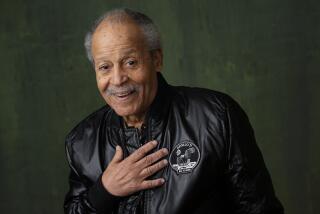Legendary NASA test pilot Bill Dana dies at 83
William H. “Bill” Dana, the famed NASA test pilot who helped usher in the space age in the 1960s by routinely flying rocket planes to new supersonic speeds and stratospheric heights, has died. He was 83.
Dana was a square-jawed aviator during an age when pilots strapped into cutting-edge aircraft and blasted it to the edges of the flight envelope -- with little assurance they would return safely. It was an era chronicled in “The Right Stuff,” Tom Wolfe’s 1979 book (and later a movie) about the early days of the space program.
He died Tuesday after a lengthy illness at an assisted living facility in suburban Phoenix. His death was announced Wednesday by NASA officials.
Like lead climbers who blaze a path up a mountain peak, test pilots help those who follow them avoid costly mistakes. Over Dana’s 48-year career, he flew more than 8,000 hours in 60-plus aircraft, including helicopters and wingless experimental rocket planes.
Several of the aircraft Dana piloted now hang in the National Air and Space Museum in Washington. However, he is perhaps most associated with the X-15 rocket plane program, which demonstrated it was possible for a winged aircraft to fly to -- and from – space. It was a feat that came 19 years before the space shuttle.
Dana was born in Pasadena on Nov. 3, 1930, and raised in Bakersfield.
After earning a master’s degree in aeronautical engineering from USC in 1958, he joined NASA as an aeronautical research engineer at the High-Speed Flight Station at Edwards Air Force Base -- now NASA’s Armstrong Flight Research Center – in the Mojave Desert.
A year later, Dana became a research pilot flying an array of aircraft that eventually led to his involvement with the X-15. At the time, it had taken about 50 years from the dawn of aviation for engineers to create an aircraft that could break the sound barrier and climb to 80,000 feet.
It took NASA and plane maker North American Aviation in Inglewood less than five years to develop and build the X-15, which could fly twice as fast as a rifle bullet. Only 12 men flew the plane, including Dana and Neil Armstrong, whose work was later overshadowed by NASA’s accomplishments with the Mercury, Gemini and Apollo programs.
Dana flew the sleek, black X-15 aircraft 16 times, reaching a top speed of 3,897 mph and a peak altitude of 306,900 feet, or nearly 59 miles. He started flying the aircraft in 1965 and was the last man ever to fly it in 1968.
Dana was later awarded civilian astronaut wings nearly 40 years later for two of his X-15 flights that exceeded 50 miles altitude. He didn’t receive that honor earlier because NASA did not give astronaut wings to its pilots.
After the X-15 program, he conducted flight experiments in a wide variety of aircraft, including Northrop’s HL-10 wingless flying wedge aircraft and Martin Marietta’s X-24B, NASA’s last manned rocket plane. The testing by Dana was essential in proving the concept of unpowered approach and landing -- a crucial feat in developing the space shuttle.
Dana later served as chief pilot at the center from 1986 to 1993, when he was responsible for recruiting, developing and training the next crop of Air Force test pilots. He later retired from flying to become the center’s chief engineer for the next five years.
Dana earned numerous awards and honors over the years, including the NASA Exceptional Service Medal, the Lancaster Aerospace Walk of Honor and the NASA Distinguished Service Medal.
More to Read
Inside the business of entertainment
The Wide Shot brings you news, analysis and insights on everything from streaming wars to production — and what it all means for the future.
You may occasionally receive promotional content from the Los Angeles Times.











